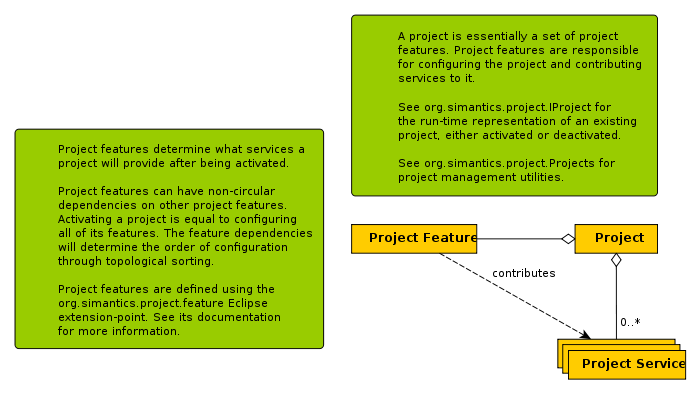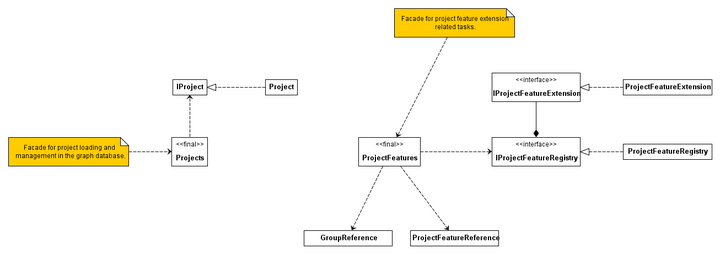Project Development
Overview
In Simantics, a semantic database is conceptually broken into projects and database configuration. A database can contain any number of projects but there are single parts of the database containing configuration data that is global for all projects. Projects are the database entities that consist of all the data produced and consumed when working a subject with Simantics.

Project Features
The Simantics project system is based on features. Abstractly speaking, a project feature in this context is a mechanism attaching life-cycle handling actions to the events of opening and closing a project. Technically, a project feature in is simply a code contribution that configures/deconfigures an IProject object when it is activated/deactivated.
An IProject is an IHintContext. The hint context aspect of IProject is used for runtime storage of all project-related properties. IHintContext allows other parties to listen to changes in these run-time project properties. For example, your project can contain properties that define project-specific services.
Project features can depend on (require) other features. This information is used to construct the order in which features configure/deconfigure a project, which is resolved through topological sorting.
Project features can be marked as published. This property is intended to be used for top-level features that configure a certain complete piece of functionality for a project. Top-level features are also intended to be presented to users in the Simantics Project Manager application (SPM, in development). Features can also be marked with installGroup definitions that are intended to be used to inform SPM of the Eclipse features that need to be installed into a provisioned workbench application in order for it to work with the particular project feature.
Basic Database Structure
The most basic structure of each Simantics database is as follows:
Root Library : L0.Library (<http:/>)- A common entry point that always exists (see Builtins.URIs.RootLibrary). All resources and data that can be deemed reachable within a database must be browsable starting from this resource.
Consists OfProjects : L0.Library (<http://Projects>)- Consists of all projects contained by the database
InstalledGraphBundles : L0.Entity (<http://InstalledGraphBundles>)- Consists of the ontology bundles (.tg files) imported into this database. This is part of database configuration. See DatabaseManagement.pgraph for the related ontology.
Adding configurability to a project
Step 1: define extensions for your project features
First add a plug-in dependency on org.simantics.project.
Extensions are defined using the org.simantics.project.feature extension point. See the extensions point's own reference document for detailed information (currently only viewable by opening the EP in eclipse).
The following example demonstrates the use of all current features of the extension point, namely project features, dependencies between project features (requires) and bindings between project features and Eclipse platform features (installGroup). This example assumes that you have a plug-in myplugin and a feature project myplugin.feature (feature id=myplugin) for it.
<syntaxhighlight lang="xml"> <extension point="org.simantics.project.feature"> <feature description="My project type's main project feature." class="myplugin.MyProjectFeature" id="myplugin.project" label="My project" published="true"> <requires id="myplugin.dummy"/> <installGroup id="myplugin.feature.group"/> </feature> <feature class="myplugin.MyDummyFeature" id="myplugin.dummy" label="My dummy feature"> </feature> </extension> </syntaxhighlight>
The above contains two project features, the first one is published and requires the second one. This means that when loading a project that uses the myplugin.project feature, myplugin.dummy feature will be configured before myplugin.project.
Step 2: define the code for the project features
Copy the following classes into corresponding source files:
<syntaxhighlight lang="java"> package myplugin; class MyProjectFeature extends AbstractProjectFeature {
private static final String DEFAULT_PERSPECTIVE = "myplugin.myperspective";
@Override public void configure() throws ProjectException { Collection<String> perspectives = new ArrayList<String>(); perspectives.add(DEFAULT_PERSPECTIVE);
getProject().setHint(ProjectKeys.DEFAULT_PERSPECTIVE, DEFAULT_PERSPECTIVE); getProject().setHint(ProjectKeys.PERSPECTIVES, perspectives); }
@Override public void deconfigure() throws ProjectException { // Dispose of anything that needs to be disposed of within the project's // hint context which can be accessed through getProjectElement(). } } </syntaxhighlight>
<syntaxhighlight lang="java"> package myplugin; class MyDummyFeature extends AbstractProjectFeature {@Override public void configure() throws ProjectException { // Setup some hints if you need to // Do something with the database getSession().syncRequest(new WriteRequest() { @Override public void perform(WriteGraph graph) throws DatabaseException { //... } }); }
@Override public void deconfigure() throws ProjectException { // Dispose of anything that needs to be disposed of within the project's // hint context which can be accessed through getProjectElement(). } } </syntaxhighlight>
Optional Step: Using ready-made project features
This step is not necessary but is here both for information and educational value. This example shows how to add a feature to your project that advertises ontology dependencies for your project which is necessary for example if (full-text) indexing of ontology dependencies is desired.
A new project feature, here myplugin.dependencies, must also be added to the previous example:
<syntaxhighlight lang="xml"> <extension point="org.simantics.project.feature"> <feature description="My project type's main project feature." class="myplugin.MyProjectFeature" id="myplugin.project" label="My project" published="true"> <requires id="myplugin.dummy"/> <requires id="myplugin.dependencies"/> <installGroup id="myplugin.feature.group"/> </feature> <feature class="myplugin.MyDummyFeature" id="myplugin.dummy" label="My dummy feature"> </feature> <feature class="org.simantics.project.features.DependencyValidationFeature:http://www.example.org/MyOntology-1.0/ImportedOntologies" id="myplugin.dependencies" label="My plugin dependencies"> </feature> </extension> </syntaxhighlight>
The myplugin.dependencies feature definition gives http://www.example.org/MyOntology-1.0/ImportedOntologies as an argument to DependencyValidationFeature which will mark the dependency on the specified namespace requirement in the project.
We still need to define the ontology containing the NamespaceRequirement we referred to in the feature. Following the instructions at org.simantics.graph create a project to contain Simantics ontologies and add a new .pgraph file into it. You can fill the .pgraph with something like the following:
<syntaxhighlight lang="python"> L0 = <http://www.simantics.org/Layer0-1.0> PROJ = <http://www.simantics.org/Project-1.0>
MY_ONTOLOGY = <http://www.example.org/MyOntology-1.0> : L0.Ontology @L0.new
//# The project feature refers to this instance MY_ONTOLOGY.ImportedOntologies : PROJ.NamespaceRequirement L0.HasDescription "Specifies the ontologies required by a this project. Used e.g. for indexing the database." PROJ.RequiresNamespace "http://www.simantics.org/Layer0-1.0" : L0.URI "http://www.simantics.org/G2D-1.0" : L0.URI "http://www.simantics.org/Diagram-2.0" : L0.URI </syntaxhighlight>
Development
Interfaces
As shown in figure 2 there are two main entry-points in the project framework:
- class Projects
- Contains utilities for loading and managing projects in a Simantics database.
- class ProjectFeatures
- Contains utilities for retrieving and filtering project feature extensions with different criteria. The implementation is backed by the project feature extension registry.

Scenarios
Load project from database and activate it
<syntaxhighlight lang="java">
public IProject loadAndActivateProject(Session session, Resource project) throws DatabaseException, ProjectException {
IProject project = Projects.loadProject(session, project);
project.activate();
return project;
}
</syntaxhighlight>
Retrieving the active project in a Simantics workbench application
The Simantics Workbench UI is built so that always when the user is working on a project, the UI will have both an active database session and an active project. The active project can be used to store any project-related services and data using the IHintContext interface it implements.
SimanticsUI (SVN) is the class for retrieving both the active database session and the active project using these:
<syntaxhighlight lang="java"> public class SimanticsUI {
...
/**
* Returns the database session context associated with the currently active
* workbench window. This method should be used to retrieve session contexts
* only when the client is sure that the correct workbench window has focus.
*
*
* If the client knows the workbench window it is working with, but it isn't * sure that the correct workbench window has focus, use * {@link #getSessionContext(Object)} instead. *
*
* @return the session context associated with the currently active
* workbench window or null if the active window has no
* session context
*/
public static ISessionContext getSessionContext() { ... }
/**
* @return the currently open and active project as an IProject or
* null if there is no active session or project
*/
public static IProject peekProject() { ... }
/**
* @return the currently open and active project as an IProject
* @throws IllegalStateException if there is no currently active database
* session, which also means there is no active project at the
* moment
*/
public static IProject getProject() { ... }
...
} </syntaxhighlight>